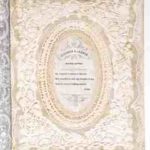Valentines
The story of St Valentine’s Day begins with some unknown medieval birdwatchers, probably in France rather than England, who reckoned that birds begin mating in mid-February, and decided to give this a precise date: 14 February. (They may have followed some folk tradition – in Slovenia this is still said to be the first day of spring, when plants start growing, and birds mate.) As was normal at that period, they expressed the date as the feast-day of a saint; in the Catholic Church every day in the year celebrates at least one saint, and for a public who had no printed calendars it was easier to remember dates by names than by figures. It happens that 14 February is dedicated to one or other of two early Roman martyrs, both named Valentinus, believed to have died on that date. This does not mean that there is anything to link the martyrs themselves to birds, or to human love; it is by arbitrary chance that their name appears, and if the birdwatchers had picked on the 15th (St Faustinus’s Day) rather than the 14th, we would be now sending one another ‘Faustines’ as love-tokens.
In the fourteenth and fifteenth centuries, it was fashionable in aristocratic circles in France and England to celebrate Valentine’s Day with flirtatious entertainments such as ‘Courts of Love’, and several poets, including Chaucer, Gower, and Charles Duke of Orleans, wrote elegant verses for the occasion. Chaucer’s ‘The Parliament of Fowls’ (1381?), describes birds gathering at the bower of ‘the noble goddess Nature’ to settle their love rivalries:
For this was on saint Valentinës day
When every fowl cometh there to chose his mate.
At the same period, one’s ‘valentine’ came to mean one’s (real or pretended) ‘sweetheart’; the poet John Lydgate used the term both for the lady to whom he addressed a Valentine’s Day poem and as the title of the poem itself. The Oxford English Dictionary cites a letter of 1477 from Margery Brews, addressed ‘Unto my right welebelovyd voluntyne John Paston, Squyer’ (she later married him), and a will of 1535 where a man leaves money ‘to my valentyn Agnes Illyon’. From then on, there are many references in poetry, plays, letters and journals to choosing valentines, drawing lots for valentines as a party game, or having to take the first person of the opposite sex whom one sees on 14 February as one’s valentine. Particularly interesting is Shakespeare’s reference in Hamlet. Ophelia, when mad, sings a song implying that it was customary for young people to go wooing on the eve of the festival – in this case, with disastrous results for the girl:
Tomorrow is Saint Valentine’s day,
All in the morning betime,
And I a maid at your window,
To be your valentine.Then up he rose and donned his clothes
And dupped the chamber door,
Let in the maid, that out a maid Never departed more.Quoth she, before you tumbled me
You promised me to wed.
So would I ha’ done, by yonder sun,
If thou hadst not come to my bed.
In the 1660s, Samuel Pepys’s diaries frequently refer to another form of the custom. Families and friends would gather on Valentine’s Eve for a party during which they would write their names on pieces of paper, and so draw lots for a pretended sweetheart. On the feast itself, and for a few days thereafter, the ‘valentines’ were expected to flirt and flatter one another, and the men would give the women presents, such as embroidered gloves or silk stockings. These gifts themselves were sometimes called ‘valentines’. Pepys and his circle also knew the idea that the first person seen that day would be one’s destined valentine; he records that in 1662 his wife walked about with her hand over her eyes to avoid seeing some workmen who were in the house.
The valentine in its modern sense of a written love-message probably originated in the mid eighteenth century, hand-written on fine paper, and became increasingly popular in the nineteenth. Commercially printed cards, elaborately decorated, appeared in England around 1840. Often the letter or card would be sent anonymously (as described in Thomas Hardy’s novel Far from the Madding Crowd, 1874), adding a teasing mystery to the custom, but also giving an opportunity for malicious hoaxes and offensive messages. Perhaps for this reason, valentine-sending had almost died out by the 1890s. For some fifty years, valentines were very rare in Britain; but in the United States (where they had been introduced in Massachusetts in 1847), they were still as popular as ever, even though America too had parodies, the ‘vinegar valentines’. After World War II commercial valentine cards suddenly reappeared in Britain in massive numbers, no doubt inspired by American marketing. Nowadays Valentine’s Day is widely publicised; cards and appropriate gifts such as chocolates, flowers, scent, and heart-shaped balloons are given; lovers meet for romantic dinners; newspaper columns are filled with sentimental messages. Hostile ‘anti-valentines’ are also available from joke stores. The feast has had its ups and downs, and at present is definitely on a high.
Alongside these well-known adult customs, there were some that were kept up by children in country districts. One was a way for the poorer ones to get a little money from better-off households, in much the same way as carol singing. Groups of them would go from house to house, reciting a verse:
Good morrow to you, Valentine!
First ’tis yours and then ’tis mine,
So please to give me a valentine.
In Norfolk in the later eighteenth century, Parson James Woodforde used to give a penny to every child under fourteen in his parish who could say ‘Good morrow Valentine’ on the right day. There is also a Norfolk custom, still known, that parents should leave a present for their own children on the doorstep; this is alleged to be a parcel from ‘Jack Valentine’, ‘Mr Valentine’, or ‘Old Father Valentine’ – who, naturally, has vanished.
As can be seen, valentine customs have a well documented history going back some eight hundred years. Unfortunately, this is not enough to satisfy the human urge.




